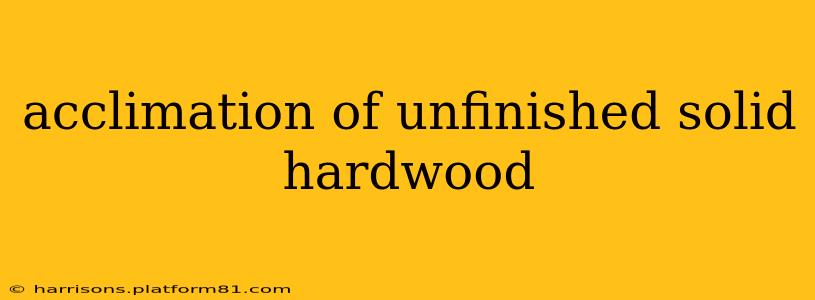Acclimating unfinished solid hardwood flooring is a crucial step before installation. Failure to properly acclimate your wood can lead to significant problems down the line, including cupping, crowning, shrinking, and gaps appearing between boards. This comprehensive guide will walk you through the process, answering common questions and providing expert advice.
What is Acclimation?
Acclimation is the process of allowing unfinished solid hardwood to adjust to the temperature and humidity levels of its intended environment. Wood is a hygroscopic material, meaning it absorbs and releases moisture based on the surrounding air. If you install hardwood that hasn't had time to adjust, its moisture content will change after installation, leading to warping and other issues.
How Long Does Acclimation Take?
The acclimation period for unfinished solid hardwood typically ranges from 7 to 10 days, but this can vary depending on several factors:
- Species of Wood: Some wood species are more susceptible to moisture changes than others.
- Thickness of Boards: Thicker boards take longer to acclimate.
- Climate Conditions: Extreme temperatures and humidity levels can prolong the process.
- Packaging: The packaging of the wood can affect how quickly it acclimates.
It's crucial to remember that this is a minimum time frame. If you're unsure, it’s always better to err on the side of caution and allow for a longer acclimation period.
How do I know if my hardwood is fully acclimated?
There's no single definitive test, but several indicators can help determine if your wood is ready:
- Measure Moisture Content: Using a moisture meter can provide the most accurate assessment. Compare the wood's moisture content to the recommended level for your climate.
- Visual Inspection: Look for changes in the wood's dimensions. If the boards are noticeably warping or changing shape, they likely need more time to acclimate.
- Feel the Wood: The wood should feel consistent to the touch, neither overly dry nor damp.
Where Should I Acclimate My Hardwood?
The ideal location for acclimation is the same room where the flooring will be installed. This ensures the wood adjusts to the precise temperature and humidity conditions. If this isn't possible, choose a location that closely mimics the room's environment. The area should be:
- Well-ventilated: Avoid airtight spaces where moisture can build up.
- Stable temperature: Avoid locations subjected to drastic temperature fluctuations.
- Protected from direct sunlight: Direct sunlight can cause uneven drying and warping.
- Away from drafts: Drafts can dry out the wood too quickly.
What if I Don't Acclimate My Hardwood?
Failing to properly acclimate your unfinished solid hardwood can result in several problems:
- Cupping: The edges of the boards curl upwards.
- Crowning: The center of the boards bulges upwards.
- Gaps: Spaces appear between the boards.
- Shrinking: Boards become shorter and narrower.
- Buckling: The boards warp severely, possibly causing damage to the subfloor.
These issues can be costly to repair or even require complete flooring replacement.
How to Acclimate Unfinished Solid Hardwood: A Step-by-Step Guide
- Inspect the Wood: Check for any damage before beginning the acclimation process.
- Unpack the Wood: Remove the wood from its packaging and allow for air circulation.
- Stack the Wood: Stack the boards flat, ensuring proper spacing for air circulation. Avoid stacking them directly on the floor; use a pallet or similar structure.
- Monitor Humidity and Temperature: Use a hygrometer and thermometer to track the room's environmental conditions. Aim for a stable temperature and relative humidity within the recommended range for your wood species.
- Allow Sufficient Time: Let the wood acclimate for at least 7-10 days, or longer if necessary.
- Measure Moisture Content: If possible, utilize a moisture meter to verify the wood's moisture content.
- Install the Flooring: Once acclimated, proceed with the installation process.
Following these steps ensures your hardwood flooring installation is successful and long-lasting. Remember, patience and attention to detail during the acclimation phase are essential for a beautiful and durable finished floor.
What is the ideal humidity level for acclimating hardwood?
The ideal humidity level for acclimating hardwood varies slightly depending on the specific wood species and your geographic location, but generally falls within the 30-50% relative humidity range. Consult the manufacturer's instructions for the most accurate guidance.
How can I control the humidity in the room where I'm acclimating the wood?
You can control humidity using a dehumidifier or humidifier to maintain the optimal range. Maintaining consistent temperature and humidity levels throughout the acclimation period is vital for achieving successful results.
Can I acclimate hardwood in a garage or basement?
While possible, it’s generally not recommended to acclimate hardwood in a garage or basement unless these spaces are climate-controlled and maintain stable temperature and humidity levels throughout the acclimation period. Fluctuations in these environments could negatively impact the acclimation process.
